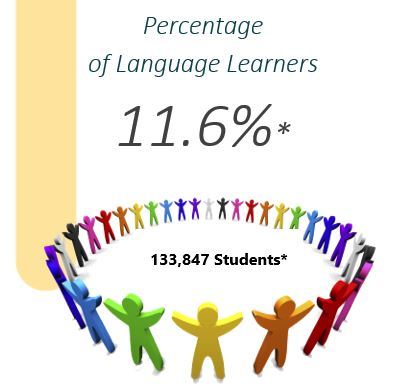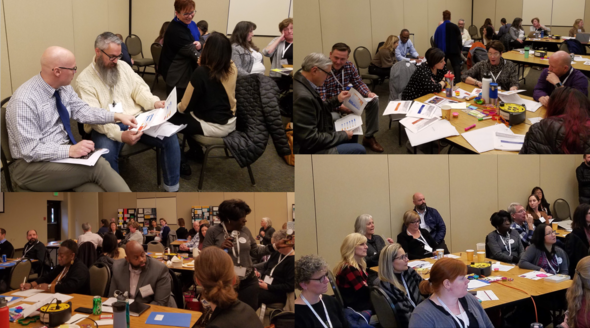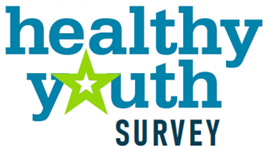|
OSSI’s monthly newsletter provides accessible resources and connects readers to best practices at the state, regional, and local level that are improving student outcomes. Do you have a story to share? Let us know about it!
FOCUS: Supporting Language Learners
February 2020
 |
|
OSPI’s vision is that all students are prepared for post-secondary pathways, careers and civic engagement. It is Superintendent Reykdal’s goal to have dual language for all students. Language Learner outcomes and growth are both federal accountability indicators under the Every Student Succeeds Act (ESSA).
Six Stages of Language Acquisition
- Pre-production
- Early production
- Speech emergent
- Beginning fluency
- Intermediate fluency
- Advanced fluency
|

Q: How can I access the Healthy Youth Survey results? A: Check out this quick guide, that will show you how to access the data in several different formats. If you have questions about the Healthy Youth Survey, contact Emily Maughan.
Continuous Improvement Partners, members of Coordinated Support Teams and leads from all nine Educational Service Districts convene with OSPI staff three times a year. During the two day convening teams discuss systems-level analysis, best practices and current research in improvement science to effectively support schools in creating inquiry-based and evidence-driven cultures of continuous improvement that enhance educational outcomes for all students.
 
|
Find step by step instructions on how to do a "QxQ analysis" with questions from the Healthy Youth Survey here
Find questions pertaining to the Language Learners on the Healthy Youth Survey here
|
|
 |

by Travis Wentworth, Data Practices Project Manager, OSSI
OSPI is driven to closing opportunity gaps between student groups with a focus on Graduation. OSPI set a target of 90 percent graduation rate for all student groups by the class of 2027. Currently, the Report Card is reporting 62.4 percent graduation rate for English Language Learners.
A study that was done using the original Washington School Improvement Framework (WSIF), showed a strong correlation between Attendance, 9th Grade on track, and Dual Credit to Graduation. Click here to see the results of that study. The Study showed that students who regularly attend school, participate in dual credit enrollment, and are on track to graduation in 9th grade, have over a 90 percent graduation rate.
Though this study focused on Race/Ethnicity, let’s look at our English Learners…
Based on 2019 Report Card data, there is there is a 2.9 percentage point gap between English Language Learners and Non-English Language Learners in Regular Attendance (80.1 percent ELL; 83.2 percent Non-ELL). When we look at 9th Grade on track numbers statewide, we see nearly a 25 percent point gap with English Language Learners at 50.9 percent compared to Non-English Language Learners at 75.1 percent on track to graduate in 9th grade. Further, Dual Credit participation rates showed nearly a 17 percent point gap with English Learners at 44.7 percent and Non-English Learners at 61.5 percent.
With an eye on closing the disproportionate graduation gap between English Language Learners and all other students, we must ask what changes do we need to make to our system to better prepare English Language Learners to be on track in 9th grade and support their inclusion within dual credit opportunities?
To look at how your local district or school compares to the State totals, navigate to the OSPI Report Card.
|
OSSI supports a team of Continuous Improvement Partners deployed throughout the state who lend their extensive professional expertise providing focused support to identified districts and schools for systems and school improvement activities in order to improve student outcomes.
 |
|
“Students are not necessarily literate in another language either... hence the testing challenge. A greater emphasis on on-going formative monitoring is needed and we need better tools!”
-Sue Connolly, Continuous Improvement Parter
|
|
“There are huge variations in the EL context from school to school and from community to community. We should be cautious not to think simple broad stroke solutions will meet the needs of students and families who have very unique circumstances.”
- Kevin Foster, Continuous Improvement Parter
|
|
 |
 |
|
“MTSS Components provide the umbrella for all student supports and services. The 8 Aspects provide a framework for Language Learner supports for consideration in planning, implementing and monitoring action steps.”
- Lee Smith, Continuous Improvement Parter
|

Attendance Works Webinar: Breakfast After the Bell, Feb 24 Register Now
Webinar: Bringing Equity Alive in the Classroom: A Guide to the Cultural Competency Modules February 27, 10:30am PST
You are invited to a webinar on the Cultural & Linguistic Competency Training Program, which is available to all LEAs at no cost. The webinar will be hosted by OSPI, PCG and curriculum author Gary Howard, and will include an introduction to culturally responsive teaching, an overview of the course platform and a chance to ask questions. register here
OSPI's Webinar- Student Discipline Data Dashboard: How to Access it and Use it Effectively, March 3, 2pm no registration, click here to join
GATE Equity Webinars, March 11, 2020, Supporting Students With Disabilities
101 10 am register here
201 3 pm register here
WABE Annual Conference, Bellevue, April 23-25
MTSS Fest, SeaTac, May 4-5
|


Focused on promoting equitable access and participation of dual credit programs, the conference will allow participants to share best practices, apply solutions to common challenges, and actively engage with education partners, organizations and agencies. Learning and applied areas of focus are: Designing Pathways, Data Measurement and Research, Student and Family Support, Partnerships, Funding and Policy.
Superintendent Chris Reykdal will provide the closing remarks Monday, sharing his passion on increasing equity and access to dual credit for all students.
Registration is now open. The registration fee for the event is $225
Summit Agenda
|

By Monica Hulubei, Continuous Improvement Partner
A positive school climate for Culturally and Linguistically Diverse (CLD) students requires knowing your students and assuring they are reflected and part of the school and classroom culture. Engaging staff regularly in Culturally Responsive Teaching Frameworks allow for reflection and analyses where student voice is absent. Consider these quotes from the referenced article, "Culturally Responsive Positive Behavior Supports" (2015) as you reflect on the impact of your school culture for CLD students.
"Culturally responsive practices involve utilizing the cultural knowledge, life experiences, and learning styles of CLD students to make learning more relevant and effective for them (Obiakor, 2008). By building upon the knowledge and strengths students bring with them from their homes and communities, culturally responsive practice validates who they are and sets high expectations for behavior and learning. It comprehensively creates an environment where diversity is affirmed and establishes a cultural lens for determining normative behavior and learning expectations (Gay, 2000; King, 2004; Nieto, 2004)"
"Classrooms are not culturally neutral terrains, but rather are constructed around sets of norms, values, and expected behaviors that are culturally bound. Low tolerance levels and expectations are an indication of the incongruence between the education strategies utilized by teachers and the cultural and linguistic differences of students that are served in an educational system in which they are required to perform based on standards that are not similar to their own."
What else does research say about cultural and linguistic competence and the implications for how English Language Learners perceive school climate?
-
Students who perceive their classrooms and schools as promoting cultural competence have an increased sense of belonging and take a greater interest in school. Read more research about cultural competency in this brief from Chiefs for Change.
-
ELL students benefit greatly from a strong sense of school belonging, yet English proficiency is an important predictor of their perceptions of positive school climate. Read more from this study.
|
Is your district looking to expand Graduation Pathway options? Do you see a need among your students to expand college readiness in math and/or ELA?
If so, please check out Bulletin 005-20 for information about the upcoming training that must be taken by any educator wanting to offer a Bridge to College Transition Course. These courses are the only transition courses that have been accepted statewide and, with a small investment of time and funding, can become an additional Graduation Pathway for your students.
|